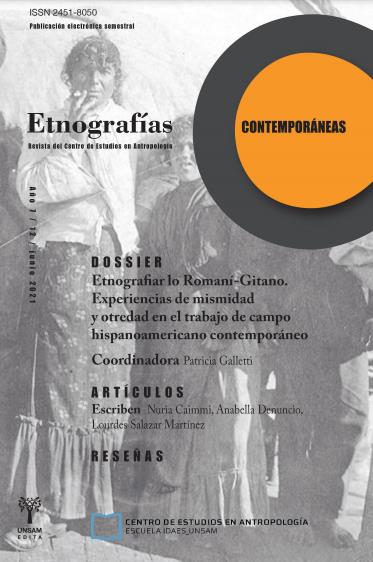Victims and justice
reflections on the Rromaní people of Colombia
Keywords:
rromaní people, victims, justice, transitionAbstract
Frameworks of Transitional Justice in Colombia”. We analyzed the situation of the Rromaní people in Colombia from an ethnographic perspective, taking into account their condition of victims of the political, social and armed conflict through three topics. First, kriss romaní as their own system of justice that confronts Transitional Justice; second, the situation of Rromaní people in two scenarios of transition that deserve to be examined, assistance and integral repair (the Unit for Victims and the Land Restitution Unit); third, the political turn that lets Rromaní people report the violation of Human Rights by different armed groups, mainly paramilitary. We conclude that forced displacement is the main impact against the Rromaní population, but this is invisibilized due to their transhumance.
References
Abbink, Jon (2001). “Violence and culture: anthropological and evolutionary psychological reflections on inter-group conflict in southern Ethiopia”. Schmidt y Schröder, Anthropology of violence and conflict. London and New York, Routledge, pp. 176-196.
Antequera, Nelson. (2010). “Cuando el río suena… Gestión de los recursos hídricos, procesos de urbanización y resolución de conflictos en los valles”. Antequeta y Laruta (ed.), Modos Originarios de Resolución de Conflictos en Pueblos Indígenas de Bolivia en los Valles y el Altiplano. La Paz, Fundación UNIR Bolivia, pp. 17-122
Arocha, Jaime (1993). “Razón, emoción y convivencia étnica en Colombia”, Revista Colombiana de Psicología, número 2, pp. 117-122.
Asad, Talal (2003). Formations of the secular. Christianism, Islam, modernity. Stanford, Stanford University Press.
Assmann, Jean y Czaplicka, John (1995). “Collective memory and culture identity”, New German Critique, number 65, pp. 125 – 133.
Barié, Cletus Gregor (2008). “Derecho Indígena y Medios Alternativos de Resolución de Conflictos”, Revista Latinoamericana de Seguridad Ciudadana, número 3, pp. 110-118.
Blimes, Randall J. (2006). “The Indirect Effect of Ethnic Heterogeneity on the Likelihood of Civil War Onset”, The Journal of Conflict Resolution, volume 50, pp. 536-547.
Botey, Francesc (1970). Los gitanos: una cultura folk desconocida. Barcelona, Nova Terra.
Brass, Paul R. (1990). “The Politics of India since Independence”. En New Cambridge History of India. Cambridge, University of Cambridge Press, pp. 129-134.
Briones, Claudia (1998). La alteridad del “cuarto mundo”. Una deconstrucción antropológica
de la diferencia. Buenos Aires, Ediciones del Sol.
Brown, Michael M. (1997). “Causes and Implications of Ethnic Conflict”. M. Guibernau y Rex, J., The Ethnicity Reader. Nationalism, Multiculturalism and Migration. Cambridge, Polity Press.
Carothers, Thomas (2002). “The End of the Transition Paradigm”, Journal of Democracy, volume 13, number 1, pp. 5-21.
Castillejo, Alejandro (2007). “Knowledge, experience and South Africa’s scenarios of forgiveness”, Radical History Review, number 97, pp. 1-32.
Castillejo, Alejandro (2009). Los archivos del dolor. Ensayos sobre la violencia y el recuerdo en la Sudáfrica contemporánea. Bogotá, Uniandes.
Castillejo, Alejandro (2013). “Historical injuries, temporality and the law: Articulations of a violent past in two transitional scenarios”, Law and Critique, number 25, pp. 1-22.
Certeau, Michel (2010). La invención de lo cotidiano I. México, Universidad Iberoamericana.
Chernick, Marck (1999). “Negotiating Peace amid Multiple Forms of Violence: The Protracted Search for a Settlement to the Armed Conflicts in Colombia”. En Arnson, Comparative peace processes in Latin America. Washington y Stanford, Woodrow Wilson, pp. 159-197.
Chirot, Daniel y Seligman, Martin (2002). Ethnopolitical Warfare. Causes, Consequences, and Possible Solutions. Washington, APA.
Clebert, Jean P. (1965). Los gitanos. Barcelona, Aymá Editores.
Cronk, Lee (2002). “From True Dorobo to Mukogodo Maasai: Contested Ethnicity in Kenya”, Ethnology, volume 41, number 1, pp. 27-49.
Departamento Nacional de Estadística (2019). Población gitana o Rrom de Colombia. Resultados del censo nacional de población y vivienda 2018.
Documento electrónico: https://www.dane.gov.co/files/investigaciones/boletines/grupos-etnicos/presentacion-grupos-etnicos-poblacion-gitana-rrom-2019.pdf, acceso: 20 de marzo de 2020.
Decreto-ley 4634. (2011, Diciembre 9). Decreto por el cual se dictan medidas de Asistencia Atención Reparación Integral y Restitución de Tierras a las víctimas pertenecientes al pueblo Rrom o Gitano. Bogotá.
Espinoza, Mónica (1995). Convivencia y Poder Político entre los Andoques. Bogotá, Universidad Nacional de Colombia.
Farmer, Paul (2004). “On Suffering and Structural Violence: A View from Below”. En Race/Ethnicity: Multidisciplinary Global Contexts, volume 3, number 1, pp. 11-28.
Foucault, Michel. (2000). La verdad y las formas jurídicas. Barcelona, Gedisa.
Galtung, Johan (1969). “Violence, Peace and Peace Research”, Journal of Peace Research, volume 6, number 3, pp. 167-191.
Galtung, Johan (1996). Peace by Peaceful Means: Peace and Conflict, Development
and Civilisation. Oslo, PRIO.
Gamboa, Juan y Paternina, Hugo (2000). Los Rom de Colombia. Itinerario de un pueblo invisible. Bogotá, PROROM.
Gamboa, Juan y Paternina, Hugo (1999). “Los gitanos: tras la huella de un pueblo nomade, Nómadas, número 10, pp. 157 – 170.
Gamboa, Juan y Rojas, Claudia (2008). “La Kriss Romaní como sistema jurídico transnacional”, Íconos, número 31, pp. 43 – 55.
Gómez, Alejandra (2016, Mayo 13). Entrevista. (A. Melo, Interviewer)
Gómez, Dalila (2011). Pueblo Rrom-Gitano- de Colombia: Haciendo Camino al Andar. Bogotá, Departamento Nacional de Planeación.
Gómez, Pablo y Reyes, Fredy (2017). Hijas de Bachué. Memoria e indigenedad desde las mujeres muiscas. Bogotá, Ediciones USTA.
Hall, Thomas D., Bartalos, Christopher, Mannebach, Elizabeth y Perkovitz, Thomas (1996). “Varieties of Ethnic Conflict in Global Perspective: A Review Essay”, Social Science Quarterly, volume 77, number 2, pp. 445-452.
Hernández, Esperanza (2004). Resistencia Civil Artesana de Paz. Bogotá, Pontificia Universidad Javeriana.
Hinton, Alexander L. (2002). Annihilating difference: The anthropology of genocide. Berkeley, University of California Press.
Hinton, Alexander L. (2011). Transitional justice: Global mechanisms and local realities after genocide and mass violence. New Jersey, Rutgers University Press.
Hoelscher, Steven (2008). “Angels of memory: photography and haunting in Guatemala City, Collective memory and the politics of urban space”, GeoJournal, number 73, pp. 195-217.
Hughes, Nancy S. (2004). Violence in War and Peace. Oxford, Blackwell Publishing.
Laruta, Carlos, Luján, Paola y Bengolea, María C. (2010). “Modos Originarios de Resolución de Conflictos Región Altiplano. Comunidades aymaras de Hilata y Coniri en el Municipio de Viacha, departamento de La Paz”. Antequeta y Laruta (ed.), Modos Originarios de Resolución de Conflictos en Pueblos Indígenas de Bolivia en los Valles y el Altiplano. La Paz, Fundación UNIR Bolivia, pp. 123-209.
Lee, Ronald. (2001). “The Rom-Vlach Gypsies and the Kris- Rromani”. En Wyrauch, Gypy Law. Romani Legal tradition and Culture. Berkeley-London, Univesity of California Press, pp. 345-392.
Líégeois, Jean Pierre. (1987). Gitanos e itinerantes. Madrid, Asociación Nacional Presencia Gitana.
Lindgren, Bjirn. (2004). “The Internal Dynamics of Ethnicity: Clan Names, Origins and Castes in Southern Zimbabwe”, Journal of the International African Institute, volume 74, number 2, pp. 173-193.
McEvoy, Kieran y McGregor, Lorna. (2008). Transitional Justice from below. Grassroots Activism and the Struggle for Change. Oxford and Portland, Hart Publishing.
Mersky, Marcie (2007). “Guatemala en la memoria. Dos experiencias de búsqueda de la verdad”. En M. Gómez, El mosaico de la memoria: experiencias locales, no oficiales o parciales de búsqueda de la verdad histórica. Bogotá, Fundación Social.
Muelas, Lorenzo (2011). La Constitución Política de 1991 y los pueblos Indígenas de Colombia. En G. Nemogá, Naciones Indígenas en los Estados Contemporáneos. Bogotá: UNAL, pp. 37-47.
Nordstrom, Carolyn y Martin, Joann (1992). The Paths to Domination, Resistance and Terror. Berkeley, University of California Press.
Nutini, Hugo G. (1997). “Class and Ethnicity in Mexico: Somatic and Racial Considerations”, Ethnology, pp. 227-238.
Oberschall, Anthony (2002). “From Ethnic Cooperation to Violence and War in Yugoslavia”. En Chirot y Seligman, Ethnopolitical Warfare. Causes, Consequences, and Possible Solutions, Washington, APA, pp. 119-150.
Pearce, W. Barnett y Littlejohn, Stephen W. (1997). Moral conflict. when social worlds collide. London, Sage.
Piasere, Leonardo (1991). Popoli delle discariche. Saggi di antropologia Zingara. Roma, CISU.
Pineda, Roberto (1985). “La rabia de Yarocamena. Etnología histórica de una rebelión indígena del Amazonas”. En Revista Tolima, número 2, pp. 29-59.
Pollak, Michael (2006). Memoria, olvido, silencio. La producción social de identidades frente a situaciones límite. La Plata, Ediciones Al Margen.
PROROM (2005). Tras el rastro de Melquiades. Memoria y resistencia de los Rom de Colombia. Bogotá, Colombia, PROROM.
PROROM (2010). Afectación del pueblo Rrom en el marco del conflicto. Carta Corte Constitucional. Bogotá.
Prunier, Gérad (2002). “Genocide in Rwanda”. En Chirot y Seligman, Ethnopolitical warfare. causes, consequences, and possible solutions, Washington: APA, pp. 109-116.
Riches, David. (1986). “The phenomenon of violence”. En Riches, Andrew, The Anthropology of Violence. Oxford, Basil Blackwell.
Robben, Antonius y Suárez, Marcelo. (2000). Cultures under siege. Cambridge, Cambridge University Press.
Sarlo, Beatriz. (2006). Cultura de la memoria y giro subjetivo. Una discusión. Buenos Aires, Siglo XXI.
Schmidt, Bettina. (2001). “The Interpretation of Violent Worldviews: Cannibalism and Other Violent Images of the Caribbean”. En Schmidt Bettina y Schröder, Ingo, Anthropology of Violence and Conflict, London and New York: Routledge, pp. 76-96.
Schröder, Ingo y Schmidt, Bettina (2001). “Violent Imaginaries and Violent Practices”. En Schröder y Schmidt, Anthropology of Violence and Conflict, London and New York: Routledge, pp. 1-24.
Schwandner-Stevers, Sievers. (2001). “The Enacment of ‘Tradition’: Albanian Constructions of Identity, Violence and Power”. En Schröder, Ingo, Anthropology of Violence and Conflict, London and New York, Routledge, pp. 97-120.
Sluka, Jeffrey A. (2000). Death squads. Philadelphia, University of Pennsylvania Press.
Sowle, Lisa. (1997). “Goods For Whom? Defining Goods and Expanding Solidarity in Catholic Approaches to Violence”, The Journal of Religious Ethics, volume 25, number 3, pp. 183-219.
Staub, Ervin. (2002). “Ethopolitical and other group violence: origins and prevention”. En Chirot y Seligman, Ethnopolitical warfare. causes, consequences, and possible solutions, Washington, APA, pp. 289-304.
Sutherland, Anne. (1986). Gypsies, the hidden Americans. Chicago: Waveland Press.
Taylor, Charles. (1993). El multiculturalismo y la política del reconocimiento. México, Fondo de Cultura Económica.
Tibi, Bassam (1996). “Old Tribes and Imposed Nation-States in the Middle East”. En Hutchinson y Smith, Ethnicity. Oxford, Oxford University Press, pp. 174-179.
Turner, Victor. (1967). The ritual process. Structure and Anti-Structure. Ney York, Cornell University Press.
Uaegrtd. (2019). Informe 2019. Documento electrónico: https://www.restituciondetierras.gov.co/, acceso: 30 de enero de 2019.
Uaegrtd. (s.f.). Restitución de derechos territoriales étnicos. Decretos – Ley 4633 y 4635 de 2011. Documento electrónico: https://www.restituciondetierras.gov.co/ restitucion, acceco: 30 de septiembre de 2017
Vynyamata, Eduard (2005). Conflictología. Curso de resolución de conflictos. Barcelona, Ariel.
Weyrauch, Walter O. (2001). “Oral Legal Traditionss of Gypsies and Some American Equivalents”. En Weyrauch, Gypsy Law, Romani Legal, Traditions and Culture, Berkeley-London, University of California Press, pp. 407-442.
Williams, Patrick. (1995). “Tsiganes parmi nous”, Hommes & Migrations, No.1188-1189, pp. 6-11.
Wilson, Richard. (2001). The politics of truth and reconciliation in South Africa. Cambridge, Cambridge University Press.
























